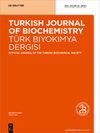The Effects of high fat diets with and without N-Acetylcysteine supplementation on the lipin-1 levels of serum and various tissues in rats
IF 0.7
4区 生物学
Q4 BIOCHEMISTRY & MOLECULAR BIOLOGY
Turkish Journal of Biochemistry-turk Biyokimya Dergisi
Pub Date : 2014-01-01
DOI:10.5505/TJB.2014.78941
引用次数: 1
Abstract
Objective: Obesity is a public health problem, but the struggle against obesity continues to increase every day. Lipin-1 is an adipokine that modulates lipid metabolism and glucose homeostasis. The aims of the current study were to compare the levels of lipin-1 in serum and tissues (liver, lung, heart, pancreas and kidney) in rat fed with low fat diet (LFD), high fat diet (HFD) and N-acetylcysteine (NAC) supplemented HFD, and to determine the relationships of the lipin-1 levels in serum and tissues with the levels of serum glucose and lipid parameters. Methods: 18 male Sprague-Dawley rats were divided into three groups: LFD group (n=6), HFD group (n=6) and the NAC-supplemented HFD (HFD+NAC) group (n=6). The feeding period of the diets was 85 days. The lipin-1 levels in serum and tissues were determined by using Rat ELISA kit. Results: In comparison to serum lipin-1 levels in HFD group were significantly lower, but heart lipin-1 levels were significantly higher (P<0.017). On the other hand, it was determined that serum and tissue lipin-1 levels were not influenced by NAC supplementation. In addition, no other significant difference in lipin-1 levels of the other tissues among the groups was found. Conclusion: This study showed that HDF affected serum and heart lipin-1 levels, while NAC supplementation did not affect on the lipin-1 levels of serum and of the tissues.高脂日粮添加和不添加n-乙酰半胱氨酸对大鼠血清和各组织脂素-1水平的影响
目的:肥胖是一个公共卫生问题,但与肥胖的斗争每天都在增加。脂素-1是一种调节脂质代谢和葡萄糖稳态的脂肪因子。本研究的目的是比较低脂日粮(LFD)、高脂日粮(HFD)和n-乙酰半胱氨酸(NAC)添加HFD的大鼠血清和组织(肝、肺、心、胰腺和肾脏)中脂素-1的水平,并探讨血清和组织中脂素-1水平与血清葡萄糖和血脂参数水平的关系。方法:雄性Sprague-Dawley大鼠18只,随机分为LFD组(n=6)、HFD组(n=6)和NAC补充HFD (HFD+NAC)组(n=6)。饲粮的饲喂期为85 d。采用大鼠ELISA试剂盒检测血清和组织中脂素-1水平。结果:与HFD组相比,HFD组血清脂素-1水平显著降低,而心脏脂素-1水平显著升高(P<0.017)。另一方面,确定血清和组织脂素-1水平不受NAC补充的影响。此外,各组其他组织的脂质-1水平无显著差异。结论:本研究表明,HDF对血清和心脏脂素-1水平有影响,而NAC对血清和组织脂素-1水平无影响。
本文章由计算机程序翻译,如有差异,请以英文原文为准。
求助全文
约1分钟内获得全文
求助全文
来源期刊
CiteScore
1.20
自引率
0.00%
发文量
0
审稿时长
6-12 weeks
期刊介绍:
Turkish Journal of Biochemistry (TJB), official journal of Turkish Biochemical Society, is issued electronically every 2 months. The main aim of the journal is to support the research and publishing culture by ensuring that every published manuscript has an added value and thus providing international acceptance of the “readability” of the manuscripts published in the journal.

 求助内容:
求助内容: 应助结果提醒方式:
应助结果提醒方式:


